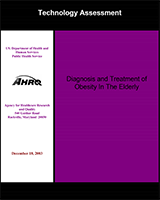NCBI Bookshelf. A service of the National Library of Medicine, National Institutes of Health.
This publication is provided for historical reference only and the information may be out of date.
Excerpt
Obesity, a disorder of body composition defined by a relative or absolute excess of body fat, is extremely common among older US adults. In 1999–2000, 33% men and 39% of women aged 65–74 were obese, as were 20% and 25%, respectively, above the age of 74. With steadily increasing prevalence in youth and younger adults, and links with adverse health outcomes, obesity has received increasing clinical and public health attention.
Diagnostic tests for obesity detect either generalized or central fat distribution. Body mass index (BMI = kg. of weight divided by the square of height in meters) is the standard clinical measure of generalized obesity. Skin fold thickness also correlates closely with overall body fat percentage. Waist circumference (WC) and waist-to-hip ratio (WHR) aim to detect central fat accumulation, as it carries increased cardiovascular risk. Accuracy and clinical relevance of these tools varies with gender and ethnicity, and possibly age.
In the general adult population, most treatment options (diet, exercise and behavioral, or pharmacologic) can lead to modest, sustainable improvements in weight, sufficient for improving intermediate health measures such as glycemic control, lipids, and blood pressure. Surgical intervention among the very obese can produce substantial weight loss and may markedly improve a number of health outcomes. However, high-quality surgical data are lacking, and while surgical adverse events are rare, they can be serious. As there are age-related differences in fat distribution, physiology, and underlying health status, the generalizability of these findings to older populations is unclear.
Aim of the Review:
To examine the data for the effectiveness of obesity diagnosis and treatment in the elderly, we conducted a systematic review of policy-relevant obesity diagnosis and treatment options in this group.
Contents
- Executive Summary
- I. Background
- II. Methods
- III. Results
- III.A Are there limitations in diagnosing obesity in the elderly with BMI? Should another measurement be used with BMI or in place of BMI for diagnosing obesity in the elderly?
- III.B Can weight loss be used as a surrogate for improved net health outcomes? If so, how much weight loss and over what time period of time?
- III.C Which elderly patients with obesity would experience an improved health outcome with weight loss treatment?
- III.D Are there dietary or behavioral therapies that improve net health outcomes in obese elderly?
- III.E Are there surgical therapies that improve net health outcomes in obese elderly?
- IV. Discussion
- References
- Appendix 1 Key Questions and Article Eligibility Criteria
- Appendix 2 Summary of Evidence Strength Criteria
- Appendix 3 Search Strategies
- Review Screening and Interventions for Childhood Overweight[ 2005]Review Screening and Interventions for Childhood OverweightWhitlock EP, Williams SB, Gold R, Smith P, Shipman S. 2005 Jul
- Review Screening and Interventions for Overweight and Obesity in Adults[ 2003]Review Screening and Interventions for Overweight and Obesity in AdultsMcTigue K, Harris R, Hemphill MB, Bunton AJ, Lux LJ, Sutton S, Lohr KN. 2003 Dec
- Review Offspring body size and metabolic profile - effects of lifestyle intervention in obese pregnant women.[Dan Med J. 2014]Review Offspring body size and metabolic profile - effects of lifestyle intervention in obese pregnant women.Tanvig M. Dan Med J. 2014 Jul; 61(7):B4893.
- Review [Simple obesity in children. A study on the role of nutritional factors].[Med Wieku Rozwoj. 2006]Review [Simple obesity in children. A study on the role of nutritional factors].Weker H. Med Wieku Rozwoj. 2006 Jan-Mar; 10(1):3-191.
- Review Screening for High Blood Pressure in Adults: A Systematic Evidence Review for the U.S. Preventive Services Task Force[ 2014]Review Screening for High Blood Pressure in Adults: A Systematic Evidence Review for the U.S. Preventive Services Task ForcePiper MA, Evans CV, Burda BU, Margolis KL, O’Connor E, Smith N, Webber E, Perdue LA, Bigler KD, Whitlock EP. 2014 Dec
- Diagnosis and Treatment of Obesity in the ElderlyDiagnosis and Treatment of Obesity in the Elderly
Your browsing activity is empty.
Activity recording is turned off.
See more...
